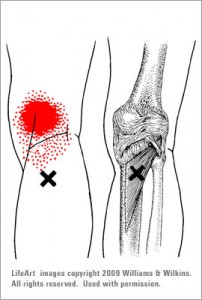Hamstring, yes! Popliteus… what’s that?
Many of us know the common muscles of the body, and are proud to be able to point them out on yourself or someone else. Now I want to make you aware of some of the important muscles of the body that may not be as familiar. Let’s start with a small muscle called the popliteus.

The above image is taken from a textbook written by Travell and Simons (the first book to buy as a physiotherapist!). It shows the relation of the popliteus muscle in the posterior aspect (back) of the knee. It is the deepest muscle of this region, and is often forgotten by therapists. The muscle does cross the tibiofemoral joint, but does so in a position that is very proximal to the joint itself, decreasing the lever arm of the muscle.
Functionally, this is a muscle that stabilizes the posterior knee (giving aide to the PCL ligament – stopping the femur from sliding anteriorly when in a squat position), as well as takes the knee out of the lock-home position. When you straighten the knee fully in a weight-bearing position, the femur slightly internally rotates on the stationary tibia to ‘lock’ the knee in position. The popliteus will then externally rotate the femur (in weight bearing) to take it out of this position.
So why do I care so much??
To an overwhelming extent have I seen knee injuries that tend to result in popliteus spasm. Often if the client is unable to get to a fully extended position, the popliteus is the cause (I am speaking now from my experiences in the clinic and on the field). As described by Travell, pain is localized normally to the posterior aspect of the knee and presents typically with squatting, walking/running (decline worse than incline), and going down stairs.
Treatment of an irritates popliteus muscle can include myofascial release and self-stretches, but it is important to have your knee assessed by a physiotherapist before starting self-therapy. There are a number of injuries that can present with pain in the posterior knee that include a PCL tear or a Baker’s cyst.
References:
Travell, J. G. & Simons, D. G. (1993). Myofascial Pain and Dysfunction: The Trigger Point Manual – The Lower Extremities. Philadelphia: Lippincott Williams & Wilkins.

